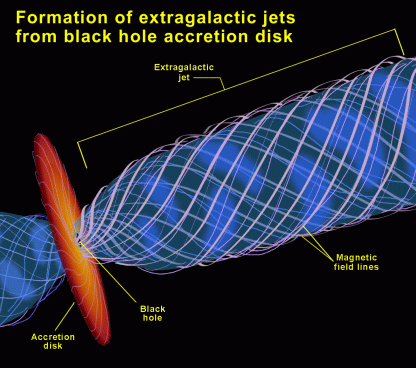Extragalactic radio sources (continued)
- The Compact Nucleus
 |
Fig 1: How are radio jets formed? This picture shows what astronomers think. |
The big question is: "what process or motor, confined in a tiny nucleus of
only a few light years
From the black hole two channels are created, perpendicular to the rotating
accretion disc, and through these channels the more energetic material can
escape attraction in two opposing directions. These channels are radio jets
inside which charged particles move at a speed close to the that of light,
spiralling along the magnetic field lines![]() ,can produce an energy which,
through narrow channels, feeds an entire radio source hundreds of thousands of
light years away?" It is by now universally recognised that the nuclei of
radio galaxies and quasars
,can produce an energy which,
through narrow channels, feeds an entire radio source hundreds of thousands of
light years away?" It is by now universally recognised that the nuclei of
radio galaxies and quasars
![]() contain massive
black holes
contain massive
black holes![]() (millions of solar masses in size), concentrated in
an area not much bigger than that of the solar system. The black hole
rotates and all the material around it (gas, star dust), attracted by
gravity, is forced by a viscosity effect to arrange itself in a rotating
disc (called accretion disc) before falling into the black hole.
(millions of solar masses in size), concentrated in
an area not much bigger than that of the solar system. The black hole
rotates and all the material around it (gas, star dust), attracted by
gravity, is forced by a viscosity effect to arrange itself in a rotating
disc (called accretion disc) before falling into the black hole.
.
|
Fig 2:
On the left, the radio image (in orange) and the optical image (in blue)
of
NGC 4261 (Credits: STScI/NRAO)
|
|
|
( Extragalattic radio sources - page 4 of 4) < Back | |

